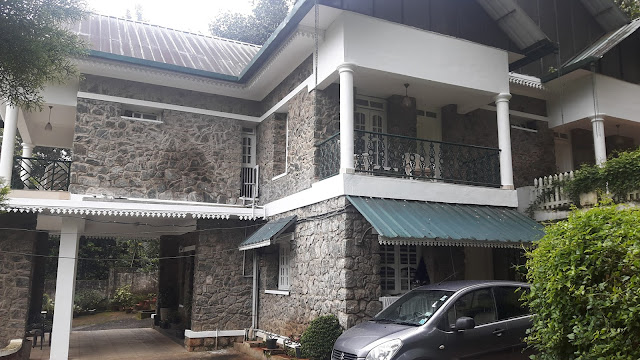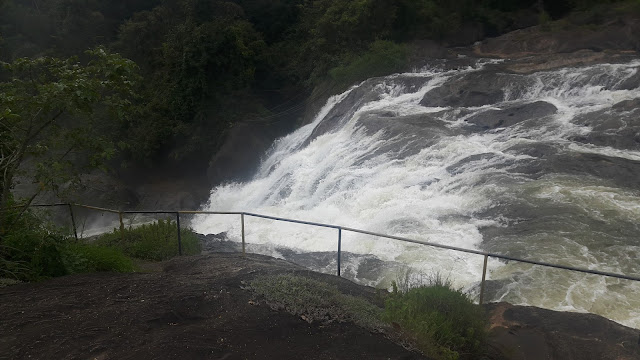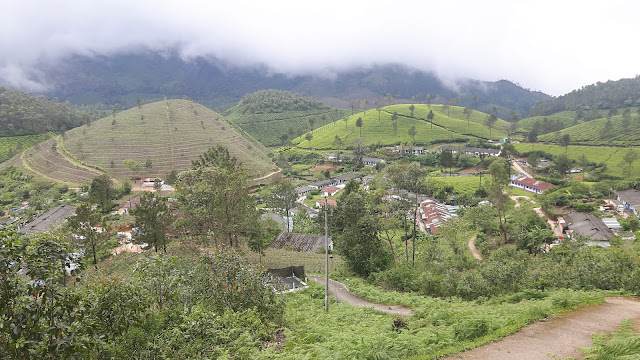Munnar is one of the top-rated hill stations of India. Though had been there twice before, I didn’t have an opportunity to explore it well. We planned a family trip two months in advance to stroll around Munnar peacefully during the Dussara holdays (Sep 2017), that’s is how we booked Chithirapuram Palace Hotel for 4 days stay. Wandering around in nature with unset goals is a very thrilling experience, as we can involve in the surprises and appreciate the wonders (everything new is a wonder!) that come along on our way. The time we ended up in Munnar was awesome and fortunately the right pick. This year rain had an unexpected pattern and the week before, it was heavily raining in Munnar. When we were there, didn't had heavy rain, but was continuously drizzling for most of the time, and experienced mist for all 5 days around the Pallivasal-Munnar stretch where we stayed.
WAY TO MUNNAR: We took a stopover at Salem, as we started on a Sunday evening from Bangalore. The road was in extremely good condition, but a considerable amount had to be spend on tolls. There are lots of eateries in this route (Bangalore – Dharmapuri - Salem – Tirupur – Udumalpet – Marayoor – Munnar). The extra ordinary stuffs to note in this route are – Textile industries in Tirupur and Wind farms in Udumalpet area. 90% of cotton export of the country are done from Tirupur! The mills actually allow to have a visit, so next time when you pass by you can try for a visit.
 |
| Wind Farms near Udumalpet |
MUNNAR -- A NATURE LOVER'S PARADISE
Munnar and Idukki district, is so special with lots of peculiarities. It is a High Range Mountain area with lots of biodiversity and many endemic [1] flora and fauna, in the Western Ghats. This is habitat to many threatened species of flowers and animals. There are 8 protected areas in this high range landscape (Eravikulam National Park, Chinnar Wildlife Sanctuary, Kurinjimala Wildlife Sanctuary, Anaimudi National Park, Pampadumshola National Park, Mathikettanshola National Park, Thattekkad Wildlife Sanctuary and Idukki Wildlife Sanctuary). This protected area constitutes to 11.96% of the hill range landscape and this region is part of one of the five viable breeding center for tiger in India. Notable endemic animals that are found near Munnar are - Nilgiri Tahr (Rajamala- Eravikulam National Park), Grizzled Giant Squirrel (Chinnar Wildlife Sactuary) and Nilagiri Marten (a kind of dog, Pampadumshola National Park). This region has high elevation montane forests and grass lands, humid high elevation forests, humid mid elevation forests, humid low elevation forests and dry forests. These levels of biodiversity are possible because of three factors – range of altitudes (Animudi peak at 2695m above MSL and the Thattekkad area at 40m) connected through cascades of precipitous cliffs and valleys, highly varies climate profile and varied set of bio-physical niches.
In the Shola area of this mountain range (at 1300m to 2400m altitude) the famous Neelakurinji (Strobilanthes Kunthianus) blooms once in 12 years. There are 46 plant species of kunji plants in India and all of them blooms in 10-16 years of range[2]. To protect this endemic plant, Kerala government formed 32Km2 protected habitat named Kurinjimala Sanctuary in 2006 and conducted Neelakurinji Fest (http://www.neelakurinji.net). The next mass flowering or blooming will happen in 2018 (Aug, Sep, Oct).
The humid high elevation area has tropical wet evergreen forest and suitable for cardamom plantations and this is the area where high degree of endemism is found in the whole Kerala state. To understand the same - the floral diversity of this range is clear from the recorded 1044 number of species of flowering plants and of which 395 are endemic to Western Ghats. Finding 39% of endemism in a specific forest range is not so common. Malayattoor, Munnar and Idukki forest divisions come under humid mid elevation forests. 34 out of 124 flowering plants (27.4%) found in this area are endemic. The vegetation here ranges from wet evergreen, semi evergreen to moist deciduous forests. The lower reaches of Malayattoor and Munnar forest divisions and Thattekkad has humid low elevation forests. This is highly degraded area and the original evergreen forests are confined to small pockets. 125 out of 728 of plants found here are endemic (17%). The north-eastern extremity of the high range has drier vegetation and some unique habitats – dry deciduous forests. Forests near Marayur and Chinnar plains are of these types. In this range, the riparian forests characterized by evergreen and semi evergreen species are restricted to fringes of streams and rivers.
To get a feel of the enormous range of biodiversity in this mountain range w.r.t Western Ghats, let’s have a look at below table,
Type
|
Endemic species/Total species found (In Western Ghats)
|
Endemic species/ Total species found (Idukki High Range)
|
Plants
|
1261/7388
|
No Data
|
Ant
|
70/350
|
No Data
|
Fish
|
118/288
|
23/72
|
Land snails
|
204/269
|
No Data
|
Odonates (dragon flies
& damsenflies)
|
69/174
|
No Data
|
Reptiles
|
139/225
|
42/122
|
Butterflies
|
34/330
|
22/265
|
Mammals
|
14/120
|
9/79
|
Amphibians
|
170/220
|
43/No Data
|
Birds
|
16/500
|
15/No Data
|
Orchids
|
112/245
|
No Data
|
Caecilia (like worms and
snakes. Without limbs)
|
16/16
|
No Data
|
Reference
|
[5], [6]
|
[1]
|
To be precise, anything that you might see in Munnar or around this hill range might be a rare or special species; whatever silly creature that we might think. Biodiversity plays a crucial role in sustaining the nature and to ensure the form and functioning of the ecosystem. It is important from the life supporting services (material and non-material), supplying fuel in various forms, regulating services (carbon sequestration, prevention of soil erosion etc), provisioning services, livelihood, ways of life, derived diverse socio-cultural values, traditional knowledge, medicinal practices based on close understanding and dependence. It is a challenge that the contemporary system of national accounting services like GDP does not account for the ecosystem services, biodiversity or the value of natural resources. It is a misleading report that only 1.5% of contribution of GDP is from forests, in our country where the geographical area of more than 20% covered by forests or mountains. It is very challenging to define a system which will holistically take care the indirect influence of biodiversity and environment on national accounting. India has started a Green National Accounting to counter this and define a system, but it’s in early stages [7]
This high range region has encatchment areas for 3 major rivers (Periyar, Thodupuzhayar and Thalayar) of Kerala state. Other main attraction of this region are cardamom and tea estates. There are 13 different tribal communities, whose tribal hamlets are deep in the forests or along the fringes. The Kattunaikar community has only one family left with 4 persons and the Muthuvan community is the largest tribal community present in the hill range with 3334 families.
DEVELOPMENTAL CONTEXT
With all these attractions in place, injudicious use of natural resources has highly damaged this high range area. Tea and Cardamom plantations, the plywood industry in Perumbavoor, Hindustan Newsprint Ltd and Kerala State Bamboo Corporation are some of the notable beneficiaries of the plant and timber from the high range. Balancing conservation of ecology, economic production and livelihood is always a tough task. In Munnar, 96% of the work force in the plantation industry. Document [3] below is one of the best report on the violations in land use in Munnar and surrounding areas.
The first tourist attraction of Munnar is the tea plantations. This high range area was under the custody of Poonjar Royal family (whose roots are from Pandya dynasty from Madurai) for long time in history. The legacy of tea plantations goes back to 1877, when the Poonjar Thampuran gave Kannan Devan Hills on lease to John Daniel Munroe (British resident of Travancore Kingdom) for tea plantations. Later Tunor (in 1879), AH Sharp (European planter in 1880) and Finley (James Finley and Company Ltd formed in 1895) planted at various locations and volumes. The Kannan Devan Hills Produce Company was formed in 1897 to manage tea estates. In 1924 there was a heavy disastrous monsoon around Munnar and large-scale replanting happened later. In 1964, Tata Group entered in collaboration with Finlay to form Tata-Finlay company. The initial agreement made by Raja was later resumed through Kannan Devan Hills Act in 1971 by Government of Kerala. Tata Tea Ltd was formed in 1983. In 2005, Kannan Devan Hills Plantations Company (KHDP) was formed when Tata Tea Ltd exited most of its plantations due to the crisis in the tea industry and re-structured to an employee owned company, ie, shareholders of the company are the employees. It has 12,000+ employees and 99.9% of them own shares in the company now. Today, as per the KHDP website [8] they own a total land of 23,783 hectares (approximately 59,000 acres) of land and accounts 31.5% of tea production of Kerala state.
Disclaimer: All photos are from my smatphone, Samsung Galaxy A8. So without sunlight the photos are not that appealing ;(
DAY 1: ROAMING AROUND MUNNAR TOWN
On the day we reached Munnar (around 3PM), the climate was soothing and the sky tend to shower, but it was wet with slight drizzle and mist. We roamed around Munnar on that day.
 |
| An evening view from Pallivasal |
 |
| Penstock leading to Pallivasal Hydro electric power station This is a landmark on the Adimali-Munnar Road |
 |
| An old walk-able hanging bridge (1942), this is behind Pizza Max showroom in the Munnar town |
 |
| Chithirapuram Palace Hotel, Chithirapuram. Rooms are decently maintained and location is very good - not very near to town, but Munnar is 4Km away from here. Good views and calm atmosphere around |
DAY 2: IDUKKI ROUTE: Neriyamangalam Power House, Idukki Dam, Ponmudi Dam, Kallimali View point, SN Puram falls
It was a long time desire to see Idukki Dam and so we decided to go to Cheruthoni. The drive from Munnar was wonderful - can feel and experience the lush greenery, the services of Periyar river, lots of dams and hydel power stations, cardamom plantations etc. With the heavy rain in previous weeks, the vegetation were charming and the dams were full.
 |
| Neriamangalam Power House. This is at Panamkutty, 28Kms from Munnar town on the way to Cheruthoni. Sound of the hydel power generators is special. |
Cheruthini-Idukki Dam site is a highly secured area (central security agency is taking care of this area) and photography is prohibited there. But it is an engineering masterpiece with a collaboration from Canadian Government, the dam constructed between Kuravan and Kurathi hills in 1970's. I thought There is an electric car service to see the entire stretch and it is worth to spend some time here.
 |
| Kulamavu, Cheruthoni and Idukki dams protecting 33Km2 area of Idukki Reservior. Idukki Wildlife Sanctuary is in middle of it. |
 |
| At Vanitha Hotel, Vellathooval (this is the place name ;)) for lunch |
After lunch from Vellathooval, we explored Kallimali view point, Ponmudi Dam and Ripples falls.
 |
| Hanging bridge at Adimali- Rajakkad Road. LMVs can be driven on this. This is over the spillway of Ponmudi Dam |
 |
| Ponmudi Dam view. It's in the Panniar river, tributary of Periyar river. |
 |
| Newly developed tourist spot - Ripple water falls at SN Puram. One of the example possibility of tourist spot development. Kerala has lots of tourist development opportunities |
 |
| Falls becomes spectacular during monsoon season |
DAY 3: Devikulam, Tea Museum, Eravikulam National Park, Chocolate Factory
Devikulam is a small village surrounded by majestic view of small round hills and valleys of tea plantations. This is one of the extra ordinary place in Kerala to see the vastness and beauty of tea plantations. The photos taken are not enough to convince the attraction of the place, I understand that my phone camera is incapable of the same ;(
 |
| On the way to Devikulam |
 |
| Tea plantations |
 |
| A beautiful house at Devikulam |
 |
| Vattekkad, A hamlet in the middle of plantations. This is off the Munnar - Devikulam Road |
 |
| These are inside tea plantations in Devikulam area. Go off the main road to expect unexceptional views with no one around, feel the beauty in loneliness. |
 |
| Sundial. A rare sight. Checked the time through the shadow line on the dial, it was correct. |
 |
| A wonderful experience! at Pallivasal |
 |
Manna Chocolate Factory at Anachal. They explain how chocolates are made and you can see it. Chocolates are slightly costlier |
 |
| Inside Kasavu Alayam. Sarees are imported from Balaramapulam, But dhothees are made here using spinning machines |
DAY 4: MUNNAR TO VATTAVADA (Mattupetty Dam, Echo Point, Kundala Dam, Top Station, Pampadumshola National Park, Vattavada)
In any trip or trail, there are unexplored locations. People get bored or loss interest towards the end of the trip, some times even miss gems. This route is of that kind. Most of the travellers end up spending lots of time shooting around Photo point, Echo point, Top station etc and drop giving a try to traverse through Pampadumshola and further to Vattavada.
 |
| Views from near Top station |
 |
| Meesapulimala and Kolukkimala can be viewed from here |
 |
Entry to Pampadumshola National Park, smallest national park of Kerala (1.32 Km2 area)
|
 |
| Valleys of Vattavada, this village is near to Tamilnadu boundary, and entry from Munnar is through Pampadum shola national park. Vattavada is 45Km away from Munnar |
 |
Vattavada is a rain shadow village. The height here varies from 1,450m to 2,695m.
It is famous for its wide variety of crops which is not seen in the other parts of Kerala.
Literacy rate is only 32% |
 |
Vattavada is becoming a vegetable hub for Kerala.
Government is seriously planning to setup reliable irrigation sources, so it can irrigate existing cropped area of 1057 Ha and conversion of 1443 ha. There are plans to build small dams for this purpose.
|
 |
A variety of fruits and vegetables cultivated here - Orange, Strawberry, Passion fruit, Avocado, Blackberry, Gooseberry, Peach, special variety of seeetha pazham, plums, marathakkali, carrot, potato, sugar cane, many types of leaves etc
|
 |
| Instructions from Kerala Government in Tamil near location called Pazhathottam |
 |
| I liked the place name ;) Nearby places are - Pazhathottam, Valakoda, Koviloor, Chilanthiyar |
 |
Purple Passion Fruit (Passiflora edulis) - grows well in cooler temperatures. The fruit is round or oval, 4-6 cm diameter and changes its colour from green to deep purple when ripe.
|
 |
| Choultry (Sathram), a rare sight |
 |
| At the Organic Strawberry Farm. They charge 400 - 500 rupees per Kg |
 |
| On the way back |
 |
| Protected Dolmens (Muniyara) |
As we had spent sufficient time at Marayoor in our last trip, we just roamed and spent lots of time driving slowly through the Chinnar sanctuary and Anamalai reserve forest, on the way back to Bangalore. Bisons, Paeacoks, Elephants, Deers, Giant squirrels etc are usual sightings here. There are options to stay in jungle lodge at reasonable prices.
Moreover, we utilised the trip to inculcate love for nature to our kids. By the end of the trip both of them started asking names of trees, birds and butterflies. My son was almost heart-broken as he couldn't see Great Hornbill and when the forest officer from Chinnar told that the banyan tree fruits will be ripen during Jan and Feb time and they will come out and we can sight them; he is now waiting for the time.
Looking out, learning and living in tune with nature is crucial for a bright tomorrow. It is sad that we, human, give less care and concern for the nature and other creatures, who themselves serve us for a sustainable living space on earth. The greediness, misconception about things, illusion and fallacy surrounds us delivering unethical and self harming actions, which has become a threat to our own life. Each of us has to be vigilant, take possible steps, care in our life and very remarkably train our young generations to become custodians of nature. Our trips should target to ponder up on these too, which might create positive impact in our life and our relationship with mother nature.
More to explore: Thoovanam Falls, Anayirangal Dam, Parambikkulam, Meesapulimala, Kolukkimala, Edamalakkudi Tribal Colony
REFERENCES:
[1] UN Project on Indian High Range Landscape (2011) - http://www.undp.org/content/dam/india/docs/EnE/GEF-Munnar%20Landscape.pdf
[2] http://indianbirds.in/pdfs/IB_10_1_Praveen_Nameer_MunnarHills.pdf
[3] INSPECTION REPORT OF THE CENTRAL TEAM CONSTITUTED TO EXAMINE VIOLATIONS OF THE FOREST CONSERVATION ACT 1980, IN MUNNAR (April 2010) http://www.moef.nic.in/downloads/public-information/Munnar%20report%20df%208.pdf
[4] Idukki district census handbook - http://www.censusindia.gov.in/2011census/dchb/3209_PART_A_IDUKKI.pdf
[5] INDIA'S FOURTH NATIONAL REPORT TO THE CONVENTION ON BIOLOGICAL DIVERSITY by Ministry of Environment and Forests Government of India 2009 (http://www.moef.nic.in/sites/default/files/India_Fourth_National_Report-FINAL_2.pdf)
[6] INDIA'S FIFTH NATIONAL REPORT TO THE CONVENTION ON BIOLOGICAL DIVERSITY by Ministry of Environment and Forests Government of India 2014 (https://www.cbd.int/doc/world/in/in-nr-05-en.pdf)
[7] Green National Accounts in India A Framework (A Report by an Expert Group Convened by the National Statistical Organization Ministry of Statistics and Programme Implementation Government of India) http://www.indiaenvironmentportal.org.in/files/file/Green_National_Accounts_in_India.pdf
[8] KHDP Website - http://www.kdhptea.com/about-us/
[9] Article - What is the point in preserving endangered species that have no practical use to humans, apart from their aesthetic appeal or their intellectual interest to biologists? https://www.scientificamerican.com/article/what-is-the-point-in-pres/
[10] http://www.globalissues.org/article/170/why-is-biodiversity-important-who-cares
[11] Assessment of Hill Top Agriculture at Vattavada Panchayat of the Highranges - http://www.cds.ac.in/krpcds/report/miniraj.pdf









































